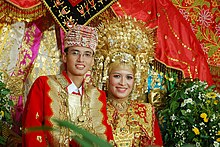
A wedding is a ceremony where two people are united in marriage. Wedding traditions and customs vary greatly between cultures, ethnic groups, races, religions, denominations, countries, social classes, and sexual orientations. Most wedding ceremonies involve an exchange of marriage vows by a couple, presentation of a gift, and a public proclamation of marriage by an authority figure or celebrant. Special wedding garments are often worn, and the ceremony is sometimes followed by a wedding reception. Music, poetry, prayers, or readings from religious texts or literature are also commonly incorporated into the ceremony, as well as superstitious customs.

An engagement or betrothal is the period of time between the declaration of acceptance of a marriage proposal and the marriage itself. During this period, a couple is said to be fiancés, betrothed,intended, affianced, engaged to be married, or simply engaged. Future brides and grooms may be called fiancée (feminine) or fiancé (masculine), the betrothed, a wife-to-be or husband-to-be, respectively. The duration of the courtship varies vastly, and is largely dependent on cultural norms or upon the agreement of the parties involved.
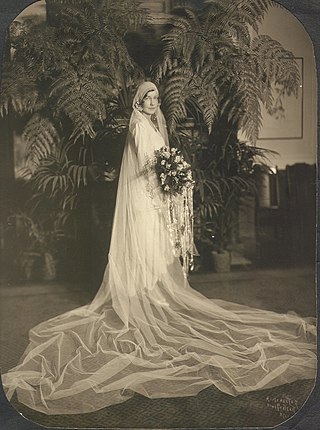
A bride is a woman who is about to be married or who is a newlywed.

A crown is a traditional form of head adornment, or hat, worn by monarchs as a symbol of their power and dignity. A crown is often, by extension, a symbol of the monarch's government or items endorsed by it. The word itself is used, particularly in Commonwealth countries, as an abstract name for the monarchy itself, as distinct from the individual who inhabits it. A specific type of crown is employed in heraldry under strict rules. Indeed, some monarchies never had a physical crown, just a heraldic representation, as in the constitutional kingdom of Belgium.
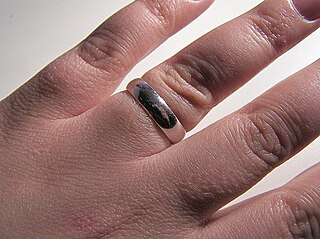
A wedding ring or wedding band is a finger ring that indicates that its wearer is married. It is usually forged from metal, traditionally gold or another precious metal. Rings were used in ancient Rome during marriage.

West Sumatra is a province of Indonesia. It is on the west coast of the island of Sumatra and includes the Mentawai Islands off that coast. West Sumatra borders the Indian Ocean to the west, as well as the provinces of North Sumatra to the north, Riau to the northeast, Jambi to the southeast, and Bengkulu to the south. The province has an area of 42,119.54 km2 (16,262.45 sq mi), with a population of 5,534,472 at the 2020 census. The official estimate at mid 2022 was 5,640,629. The province is subdivided into twelve regencies and seven cities. It has relatively more cities than other provinces outside Java, although several of them are relatively low in population compared with cities elsewhere in Indonesia. Padang is the province's capital and largest city.

A wedding dress or bridal gown is the dress worn by the bride during a wedding ceremony. The color, style and ceremonial importance of the gown can depend on the religion and culture of the wedding participants. In Western culture, the wedding dress is most commonly white, a fashion made popular by Queen Victoria when she married in 1840. In Eastern cultures, brides often choose red to symbolize auspiciousness.

Rendang is a Minangkabau dish. It is a rich meat dish that has been slow cooked and braised in a coconut milk and seasoned with a herb and spice mixture over a period of several hours until the liquids evaporate, and the meat turns dark brown and tender, becoming caramelized and infused with rich flavours.

A Mangalsutra, or Tali, is a necklace that the groom ties around the bride's neck in the Indian subcontinent, in a ceremony called Mangalya Dharanam within a Hindu wedding. The necklace serves as a visual marker of status as a married Hindu woman.
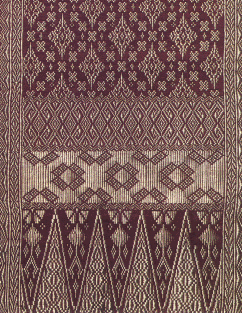
Songket or sungkit is a tenun fabric that belongs to the brocade family of textiles of Brunei, Indonesia, Malaysia, and Singapore. It is hand-woven in silk or cotton, and intricately patterned with gold or silver threads. The metallic threads stand out against the background cloth to create a shimmering effect. In the weaving process the metallic threads are inserted in between the silk or cotton weft (latitudinal) threads in a technique called supplementary weft weaving technique.
Khada dupatta is the traditional wedding dress of Hyderabadi Muslim brides in the Indian subcontinent. It is an elaborate wedding ensemble comprising a kurta (tunic), chooridaar, and a 6-yard dupatta.
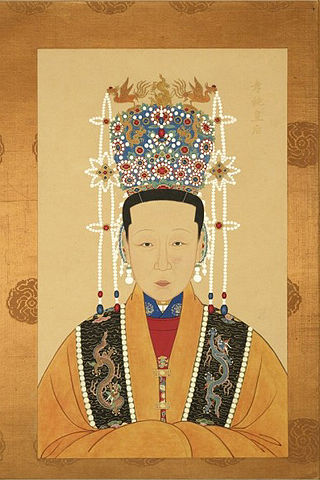
Fengguan, also known as phoenix coronet or phoenix hat, is a type of guan for women in Hanfu. It was worn mainly by noblewomen for ceremonies or official occasions. It is also traditional headgear for brides and could be worn in set of Traditional Chinese wedding dress attire, such as the fengguan xiapei.
Attire of Mangalorean Catholics refers to the traditional clothing of the Mangalorean Catholics from the Mangalore Diocese on the southwestern coast of India.

The national costume of Indonesia is the national attire that represents the Republic of Indonesia. It is derived from Indonesian culture and Indonesian traditional textile traditions. Today the most widely recognized Indonesian national attires include batik and kebaya, although originally those attires mainly belong within the island of Java and Bali, most prominently within Javanese, Sundanese and Balinese culture. Since Java has been the political and population center of Indonesia, folk attire from the island has become elevated into national status.

A Minangkabau marriage involves the distinct cultural practices and customs of the Minangkabau people, indigenous to West Sumatra, Indonesia.

Traditionally a bridal crown is a headdress that, in Central and Northern Europe, single women wear on certain holidays, at festivals and, finally, at their wedding. Bridal crowns today, of another type, are also often provided by church parishes for the use of brides at their weddings.
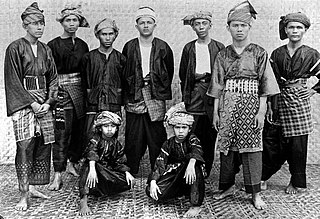
Tengkolok, also known as Tanjak, Destar is a traditional Malay or Indonesian and male headgear. It is made from long songket cloth folded and tied in a particular style (solek). Nowadays, it is usually worn in ceremonial functions, such as royal ceremonies by royalties, and wedding ceremonies by grooms.

Traditional Hajong marriage is a ceremonial ritual that involves a marriage established by pre-arrangement between families. Within Hajong culture, romantic love and widow re-marriage was allowed, and monogamy was the norm for the Hajong people.
Shinto weddings, Shinzen kekkon, began in Japan during the early 20th century, popularized after the marriage of Crown Prince Yoshihito and his bride, Princess Kujo Sadako. The ceremony relies heavily on Shinto themes of purification, and involves ceremonial sake drinking of three cups three times, the nan-nan-san-ku-do. Shinto weddings are in decline. Fewer Japanese people get married, and those who do often choose Western-style chapel ceremonies.

Minangkabau culture is the culture of the Minangkabau ethnic group in Indonesia, part of the Indonesian culture. This culture is one of the two major cultures in the Indonesian archipelago which is very prominent and influential.

